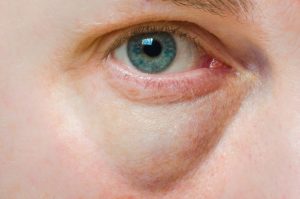 The thyroid can contribute to thyroid eye diseases including proptosis which causes bulging of the eyes. Researchers at the Schepens Eye Research Institute of Massachusetts Eye and Ear have identified new underlying mechanisms of proptosis. The researchers described vascular growth factors that cause abnormal proliferation of blood vessels which may contribute to proptosis. The findings may help target better treatments and therapies for the thyroid eye disease.
The thyroid can contribute to thyroid eye diseases including proptosis which causes bulging of the eyes. Researchers at the Schepens Eye Research Institute of Massachusetts Eye and Ear have identified new underlying mechanisms of proptosis. The researchers described vascular growth factors that cause abnormal proliferation of blood vessels which may contribute to proptosis. The findings may help target better treatments and therapies for the thyroid eye disease.
Corresponding author Leo A. Kim said, “We’ve found that there is a proliferation of blood vessels, and, to our surprise, in some of those acute cases, lymphatic vessels do form where there normally aren’t any. Our results suggest that it might be possible to treat the inflammation and swelling by stopping the blood vessels from forming and leaking fluid, or, alternatively, by finding a way to promote lymphatic vessel formation and enhance drainage of fluid. This study opens a path to exploring non-surgical treatments.”
Advertisement
The thyroid’s main responsibility is to regulate and produce hormones. When the thyroid is healthy and there are normal hormone levels in the blood, this is referred to as euthyroid. If there is a problem with the thyroid it can either produce too many hormones or too few; these conditions are referred to as hyperthyroid or hypothyroid. When a malfunction occurs with the thyroid it can lead to the onset of a thyroid eye disease.
One in five people will suffer from a thyroid eye disease and women are more likely to develop them than men. Thyroid eye disease is commonly seen in individuals with a hyperthyroid as opposed to a hypothyroid. Lastly, thyroid eye disease is seven times more likely to develop in smokers than non-smokers.
Causes and symptoms of thyroid eye disease
Thyroid eye disease causes are still unknown, but it is thought they are caused by an abnormal immune response which targets healthy eye tissues. This can lead to inflammation of the eye which can result in something like a permanent stare.
Symptoms of thyroid eye disease are:
- Redness of the eye
- Swelling, watery eyes
- Sensitivity to light
- Retraction of the eyelid
- Protruding eyes
- Dry eye
- Blurry vision
- Double vision
- Limited eye movement
Treatment and prevention of thyroid eye disease
To treat thyroid eye disease the goal is to treat the symptoms. Treatment of thyroid eye disease may include:
- Liquid tears to combat dry eyes
- Ointments, eye patches or even tape to close the eyelid if they do not close at night
- Night time head elevation if swelling occurs in the evening
- Wearing specific glasses to treat blurry or double vision
- Steroid or steroid-like medication to combat worsening vision
When to see a doctor for thyroid eye disease
You should see a doctor for thyroid eye disease if you experience any of the following symptoms:
- Changes in appearance of the eyes
- Feeling of grittiness of the eyes
- Dry or watery eyes
- Sensitivity to light
- Swelling or feeling fullness of one or both eyes
- Bangs under the eyes
- Blurred or double vision
- Pain in or around the eyes
- Difficulty moving the eyes
Because the cause is unknown for thyroid eye disease there are no suggested prevention methods. Ensure as you age that you get your thyroid checked out and treat conditions like hyperthyroid or hypothyroid.

